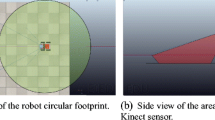Abstract
Intelligent optimization algorithms are simple, efficient and adaptive; as a result, they have been used to solve path planning problems. However, the traditional algorithms are easily trapped into local optima caused by sub-optimal paths. To overcome this problem, a path planner based on multivariant optimization algorithm with absorption strategy is proposed. A path planning problem is translated into an optimization problem through describing a path by a Bezier curve. Then, the proposed algorithm is employed to locate the optimal control points of a Bezier path. The global optimal solution is located through iteration of alternate global explorations and local refinements by intelligent searchers named as atoms in the multivariant optimization algorithm. The good performance of the proposed algorithm is ensured by the efficient communication and cooperation among atoms which have variant responsibilities. Atoms in the global group are responsible for exploring the whole solution space to locate potential areas. Then, groups of local atoms exploit these potential areas for local refinements. To improve the efficiency of multivariant optimization algorithm through reducing the redundant exploitation in the same area, the absorption strategy is introduced, i.e., local groups will merge if they move into the same search area. Experiments, which are based on benchmark maps from a commercial video game and literature, are carried out to compare the proposed algorithm with some state-of-the-art heuristic path planning algorithms. Results show that our proposed method is superior in optimality, stability and efficiency.




Similar content being viewed by others
Explore related subjects
Discover the latest articles, news and stories from top researchers in related subjects.References
Brahmi H, Ammar B, Alimi AM (2013) Intelligent path planning algorithm for autonomous robot based on recurrent neural networks. In: Proc. 2013 IEEE Conf. on advanced logistics and transport, Sousse, Tunisia, pp 199–204
Demšar J (2006) Statistical comparisons of classifiers over multiple data sets. J Mach Learn Res 7(1):1–30
Djurišić AB (1998) Elite genetic algorithms with adaptive mutations for solving continuous optimization problems–application to modeling of the optical constants of solids. Optics Commun 151(1):147–159
Gou CX, Shi XL, Li BL et al (2014) Multivariant optimization algorithm with absorption for multimodal optimization. Appl Mech Mater 483:458–464
Kamyab S, Eftekhari M (2013) Using a self-adaptive neighborhood scheme with crowding replacement memory in genetic algorithm for multimodal optimization. Swarm Evolut Comput 12:1–17
Li BL, Shi XL, Gou CX et al (2014) Multivariant optimization algorithm for multimodal optimization. Appl Mech Mater 483:453–457
Liang JJ et al (2014) Comparison of three different curves used in path planning problems based on particle swarm optimizer. Math Probl Eng. doi:10.1155/2014/623156
Liang JJ, Song H, Qu BY, Mao XB (2012) Path planning based on dynamic multi-swarm particle swarm optimizer with crossover. In: Huang DS, Ma J, Jo KH, Gromiha MM (eds) Intelligent computing theories and applications, lecture notes in artificial intelligence, 1st edn. Springer, Berlin, pp 159–166
Liu C, Gao Z, Zhao W (2012) A new path planning method based on firefly algorithm, In: Proc. Fifth IEEE Conf. on computational sciences and optimization, Harbin, China, pp 775–778
Miao Q, Khamis A, Karray FO, Kamel MS (2011) Global optimal path planning for mobile robots based on hybrid approach with high diversity and memorization. In: Kamel M, Karray F, Gueaieb W, Khamis A (eds) Autonomous and intelligent systems, lecture notes in artificial intelligence. Springer, Berlin, pp 1–10
Ostadmohammadi Arani B, Mirzabeygi P, Shariat Panahi M (2013) An improved PSO algorithm with a territorial diversity-preserving scheme and enhanced exploration–exploitation balance. Swarm Evolut Comput 11:1–15
Raja P, Pugazhenthi S (2012) Optimal path planning of mobile robots: a review. Int J Phys Sci 7(9):1314–1320
Shi Y, Eberhart R C (1998) A modified particle swarm optimizer. In: Proc. IEEE international conference on evolutionary computation, AK, Anchorage, pp 69–73
Sturtevant NR (2012) Benchmarks for grid-based path finding. IEEE Trans Comput Intell AI Games 4(2):144–148
Wang XZ, Ashfaq RAR, Fu AM (2015) Fuzziness based sample categorization for classifier performance improvement. J Intell Fuzzy Syst 29(3):1185–1196
Yang XS (2009) Firefly algorithms for multimodal optimization. In: Watanabe O, Zeugmann T (eds) Stochastic algorithms: foundations and applications, proceedings, lecture notes in computer science. Springer, Berlin, pp 169–178
Yang XS (2010) Firefly algorithm, stochastic test functions and design optimisation. Int J Bioinspir Comput 2(2):78–84
Zhan TS, Kao CC (2010) Modified PSO method for robust control of 3RPS parallel manipulators. Math Probl Eng. doi:10.1155/2010/302430
Zhang QH, Li BL, Liu YJ et al (2014) Data clustering using multivariant optimization algorithm. Int J Mach Learn Cybern. doi:10.1007/s13042-014-0294-5
Zhang J, Chau KW (2009) Multilayer ensemble pruning via novel multi-sub-swarm particle swarm optimization. J Univ Comput Sci 15(4):840–858
Zhu ZX, Zhou JR, Ji Z, Shi YH (2011) DNA sequence compression using adaptive particle swarm optimization-based memetic algorithm. IEEE Trans Evolut Comput 15(5):643–658
Acknowledgments
Sponsored by the National Natural Science Foundation of China (Nos. 11303094, 11504188, and U1404614), the Science and Technology Foundation of Henan Province of China (Nos. 142102310562, 162102310479), the Science and Technology Foundation of Henan Educational Committee of China (Nos. 16A413012, 16A510009, 15B520022, 14A520057) and the Special Project of Nanyang Normal University (No. ZX2016010).
Author information
Authors and Affiliations
Corresponding author
Rights and permissions
About this article
Cite this article
Li, B., Hui, M., Zhu, Y. et al. A path planner based on multivariant optimization algorithm with absorption. Int. J. Mach. Learn. & Cyber. 8, 1743–1750 (2017). https://doi.org/10.1007/s13042-016-0555-6
Received:
Accepted:
Published:
Issue Date:
DOI: https://doi.org/10.1007/s13042-016-0555-6




